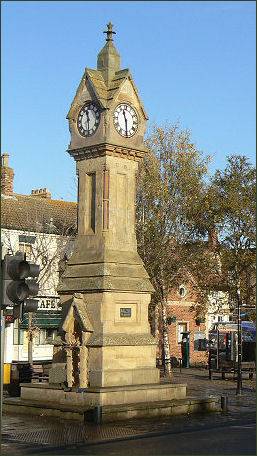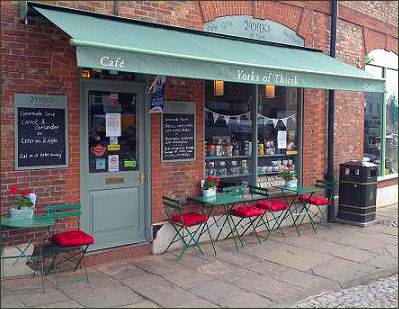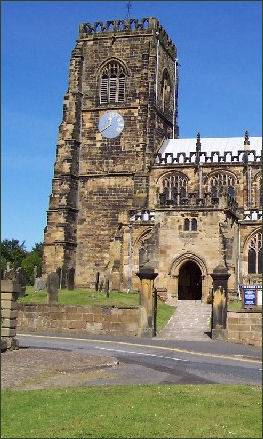Thirsk
OS grid reference:- SE 429 820
 The traditional market town of Thisk in North Yorkshire lies in the Vale of Mowbray. Thirsk and its adjoining neighbour Sowerby are located in what today is thought of as Herriot Country.
The traditional market town of Thisk in North Yorkshire lies in the Vale of Mowbray. Thirsk and its adjoining neighbour Sowerby are located in what today is thought of as Herriot Country.
 Cod Beck runs through the centre of the town. The area to the east of the river is known as Old Thirsk. The name is said to derive from the Viking (Old Norse) word ūresk which means fen or lake.
Cod Beck runs through the centre of the town. The area to the east of the river is known as Old Thirsk. The name is said to derive from the Viking (Old Norse) word ūresk which means fen or lake.
Local archeological finds indicate there was a settlement there as early 500-600 BC. The town is referred to in the Domesday Survey of 1086 as Tresche.
At the time of the Norman conquest the manor was owned by the Saxons Orm and Thor. Post conquest manor it was split between Hugh, son of Baldric and the king. Much of the land was later granted to the influential Norman lord, Robert de Mowbray, after whom the surrounding vale is named.
The manor continued to be owned by the Mowbray family until the family became extinct in the male line. With no direct succession, it passed to the heiress Lady Isabel Mowbray, who had married into the Berkeley family. Her son William de Berkeley, 1st Marquess of Berkeley, given the epithet "The Waste-All" by the family biographer and steward, then inherited the manor on her death.
It remained with this family until 1723 when it was sold to Ralph Bell of Sowerby. It remained in the Bell family into the twentieth century.
The Mowbrays built a castle on the north side of present-day Castlegate, by 1176 the castle was completely destroyed after an uprising against King Henry II. The Mowbrays then built a manor house on the site but this was later destroyed by the Scots in 1322. The first Tudor king, Henry VII raised unpopular taxes that resulted in uprisings in the north. This led to the murder of the Henry Percy, 4th Earl of Northumberland, allegedly on The Little Green, when he was sent to collect the taxes. However, other evidence points to the murder occurring in nearby South Kilvington.
 Thirsk centres around a characterful cobbled market square, dominated by the town clock, it boasts Monday & Saturday markets and independent shopping with a range of interesting shops. The market place is edged by pubs, most of which provide food and accommodation. Most of the shops are still around the market place.
Thirsk centres around a characterful cobbled market square, dominated by the town clock, it boasts Monday & Saturday markets and independent shopping with a range of interesting shops. The market place is edged by pubs, most of which provide food and accommodation. Most of the shops are still around the market place.
Thirsk was home to the veterinary surgeon and author James Herriot. Thirsk was referred to as Darrowby in his books. His veterinary practice at 23 Kirkgate in Thirsk which now houses The World of James Herriot Museum, dedicated to Herriot's life and works.
Skeldale House, the location of the museum, was the real home of veterinarian Alfred Wight, portrayed as James Herriot in his books and TV series. When Alf Wright died in 1995, Hambleton District Council bought the house and began a restoration programme on the building. This included a recreation of the original living quarters and sets from the All Creatures Great and Small television series based on the books.
Thirsk also has a museum with exhibits from across the whole history of the town. This is situated in the house in which the the founder of Lord's Cricket Ground, Thomas Lord was born. Many visitors come to enjoy a day out at Thirsk Racecourse, which is one of the finest in Yorkshire. Racing takes place from April to September each year.
The fifteenth century parish church is dedicated to St Mary (pictured right). The church is built in Perpendicular Gothic style and is often referred to as the cathedral of North Yorkshire because of its 80 feet high tower. There is also a Friends Meeting House in Kirkgate which has stood there since at least 1799. There are 20 Blue Plaques marking buildings important in themselves or associated with noteworthy Thirsk residents. A leaflet detailing the Thirsk and Sowerby Blue Plaques Trail, a walk around 19 of them is available from Thirsk Tourist Information centre in the market place.
